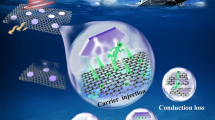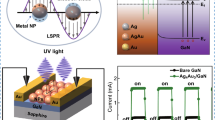Abstract
Novel optical properties of the nanopatterned graphene in the infrared and terahertz can be enhanced and tailored. The underlying nature is the excited plasmon of the patterned graphene with sub-wavelength feature sizes induce high optical field confinement, low intrinsic loss, and diverse optical tunability. Thus, high-quality graphene nanoarrays with fine nanostructures and low surface roughness should be needed to precisely adjust the graphene plasmon-enhanced optical properties. Here, electron beam exposure and inductively coupled plasma (ICP) etching techniques were used to fabricate the single-layer graphene nanodot array (GNDA) with a minimum size of 90 nm and a surface roughness of 0.846 nm. The measured absorption spectra in the infrared and terahertz range show an enhanced absorption compared to the unpatterned graphene, and a maximum rate of 10% is adopted in the infrared spectra. The absorption peaks undergo a slight red shift with the dot size increase. The experimental results show a good agreement with the numerical simulation. The results in our work provide a path to design and fabrication of novel photodetectors based on graphene’s plasmonic excitations with good light sensitivity and frequency selectivity.





Similar content being viewed by others
Data Availability
The datasets generated during the current study are not publicly available due to inconvenient documents to organize but are available from the corresponding author on reasonable request.
References
Goldflam M, Ruiz I, Howell S, Tauke-Pedretti A et al (2020) Monolithically-fabricated tunable long-wave infrared detectors based on dynamic graphene metasurfaces. Appl Phys Lett 116:191192. https://doi.org/10.1063/5.0007780
Zhao Z, Li G, Yu F, Yang H, Chen X, Lu W (2018) Sub-wavelength grating enhanced ultra-narrow graphene perfect absorber. Plasmonics 13:2267–2272. https://doi.org/10.1007/s11468-018-0748-9
Yao W, Tang L, Nong J, Wang J, Yang J, Jiang Y, Shi H, Wei X (2020) Electrically tunable graphene metamaterial with strong broadband absorption. Nanotechnology 32:075703. https://doi.org/10.1088/1361-6528/abc44f
Fei Z (2018) Electrically detecting infrared light. Nature Mater 17:950–951. https://doi.org/10.1038/s41563-018-0207-1
Manpreet K, Manmeet K, Virender S (2018) Nitrogen-doped graphene and graphene quantum dots: A review onsynthesis and applications in energy, sensors and environment. Adv Colloid Interfac 259:44–64. https://doi.org/10.1016/j.cis.2018.07.001
Bao W, Jing L, Velasco J, Lee Y, Liu G, Tran D, Standley B, Aykol M, Cronin SB, Smirnov D, Koshino M, McCann E, Bockrath M, Lauet CN (2011) Stacking-dependent band gap and quantum transport in trilayer graphene. Nature Phys 7:948–952. https://doi.org/10.1038/nphys2103
Freitag M, Low T, Zhu W, Yan H, Xia F, Avouris P (2013) Photocurrent in graphene harnessed by tunable intrinsic plasmons. Nat Commun 4:1951. https://doi.org/10.1038/ncomms2951
Eddin FBK, Fen YW, Sadrolhosseini AR, Josephine YCL, Daniyal WMEMM (2022) Optical property analysis of chitosan-graphene quantum dots thin film and dopamine using surface plasmon resonance spectroscopy. Plasmonics 17:1985–1997. https://doi.org/10.1007/s11468-022-01680-1
Cakmakyapan S, Sahin L, Pierini F, Ozbay E (2014) Resonance tuning and broadening of bowtie nanoantennas on graphene. Photonic Nanostruct 12:199–204. https://doi.org/10.1016/j.photonics.2014.02.001
Xiong L, Forsythe C, Jung M et al (2019) Photonic crystal for graphene plasmons. Nat Commun 10:4780. https://doi.org/10.1038/s41467-019-12778-2
Garaj S, Hubbard W, Reina A, Kong J, Branton D, Golovchenko JA (2010) Graphene as a subnanometre trans-electrode membrane. Nature 467:190–193. https://doi.org/10.1038/nature09379
Nikitin AY, Guinea F, Martin-Moreno L (2012) Resonant plasmonic effects in periodic graphene antidot arrays. Appl Phys Lett 101:151119. https://doi.org/10.1063/1.4760230
Yan H, Low T, Guinea F, Xia F, Avouris P (2013) Tunable phonon-induced transparency in bilayer graphene nanoribbons. Nano Lett 14:4581. https://doi.org/10.1021/nl501628x
Fei Z, Rodin A, Andreev G et al (2012) Gate-tuning of graphene plasmons revealed by infrared nano-imaging. Nature 487:82–85. https://doi.org/10.1038/nature11253
Ma Y, Zhi L (2022) Functionalized graphene materials: definition, classification, and preparation Strategies. Acta Phys Chim Sin 38:2101004. https://doi.org/10.3866/PKU.WHXB202101004
Wang M, Huang Y, Yu L, Song Z, Liang D, Ruan S (2018) Multiwavelength thulium-doped fiber laser using a micro fiber-optic fabry–perot interferometer. Photon J 10:1–8. https://doi.org/10.1109/JPHOT.2018.2849998
Baik S, Kim J, Lee HJ, Lee TH, Pang C (2018) Highly adaptable and biocompatible octopus-like adhesive patches with meniscus-controlled unfoldable 3D microtips for underwater surface and hairy skin. Adv Sci 5:1800100. https://doi.org/10.1002/advs.201800100
Liu F, Cubukcu E (2013) Tunable omnidirectional strong light-matter interactions mediated by graphene surface plasmons. Phys Rev B 88:3925–3938. https://doi.org/10.1103/PhysRevB.88.115439
Wenger T, Viola G, Kinaret J, Fogelström1 M, Tassin P (2017) High-sensitivity plasmonic refractive index sensing using graphene. 2D Mater 4:025103. https://doi.org/10.1088/2053-1583/aa70ff
Yan H, Li X, Chandra B et al (2012) Tunable infrared plasmonic devices using graphene/ insulator stacks. Nature Nanotech 7:330–334. https://doi.org/10.1038/nnano.2012.59
Rodrigo D, Limaj O, Janner D et al (2015) Mid-infrared plasmonic biosensing with graphene. Science 349:165–168. https://doi.org/10.1126/science.aab2051
Liu Y, Gong T, Zheng Y et al (2018) Ultra-sensitive and plasmon-tunable graphene photodetectors for micro-spectrometry. Nanoscale 10:20013–20019. https://doi.org/10.1039/C8NR04996C
Wu C, Liu N, Hu H, Guo X, Liao B, Liu J, Wang L, Chen C, Yang X, Dai Q (2019) Detecting molecular vibrational modes of side chains and endpoints in nanoscale proteins with graphene plasmon. Chin Opt Lett 17:062401. https://doi.org/10.3788/COL201917.062401
Ye L, Sui K, Zhang Y, Liu K (2019) Broadband optical waveguide modulators based on strongly coupled hybrid graphene and metal nano-ribbons for near-infrared applications. Nanoscale 11:3229–3239. https://doi.org/10.1039/C8NR09157A
Zhu AY, Cubukcu E (2015) Graphene nanophotonic sensors. 2D Mater 2:032005. https://doi.org/10.1088/2053-1583/2/3/032005
Hu H, Yang X, Zhai F, Hu D, Liu R, Liu K, Sun Z, Dai Q (2016) Far-field nanoscale infrared spectroscopy of vibrational fingerprints of molecules with graphene plasmons. Nat Commun 7:12334. https://doi.org/10.1038/ncomms12334
Zundel L, Manjavacas A (2017) Spatially resolved optical sensing using graphene nanodisk arrays. ACS Photonics 4:1831–1838. https://doi.org/10.1021/acsphotonics.7b00405
Zhang K, Zhang L, Yap FL, Song P, Qiu CW, Loh KP (2016) Large-area graphene nanodot array for plasmon-enhanced infrared spectroscopy. Pub Med 12:1302–1308. https://doi.org/10.1002/smll.201503016
Falkovsky LA (2008) Optical properties of graphene. J Phys 129:012004. https://doi.org/10.1088/1742-6596/129/1/012004
Kuzmin DA, Bychkov IV, Shavrov VG, Temnov VV (2017) Plasmonics of magnetic and topological graphene-based nanostructures. Nanophotonics 7:597–611. https://doi.org/10.1515/nanoph-2017-0095
Hutter E, Fendler J (2004) Exploitation of localized surface plasmon resonance. Adv Mater 16:1685–1706. https://doi.org/10.1002/adma.200400271
Hwang EH, Sarma SD (2007) Dielectric function, screening, and plasmons in two-dimensional graphene. Phys Rev B Condens 75:205418.1–205418.6. https://doi.org/10.1103/PhysRevB.75.205418
Zayats AV, Smolyaninov II, Maradudin AA (2005) Nano-optics of surface plasmon polaritons. Phys Rep 408:131–314. https://doi.org/10.1016/j.physrep.2004.11.001
Zeranska-Chudek K, Lapinska A, Wroblewska A, Judek J, Duzynska A, Pawlowski WAM, Zdrojek M (2018) Study of the absorption coefficient of graphene-polymer composites. Sci Rep 8:9132. https://doi.org/10.1038/s41598-018-27317-0
Funding
This work was partially supported by Sichuan Science and Technology Program (Grant No. 2023YFH0089) and State Grid Science and Technology Project “Research on broadband electromagnetic measurement technology based on spectral characteristics of Rydberg atoms and Tunnel Magneto Resistance effect” (No. 5700-202127198A-0-0-00).
Author information
Authors and Affiliations
Contributions
All authors contributed to the study conception and design. Material preparation, data collection, and analysis were performed by Zilong Yan, Fengjiang Peng, Ruotong Chen, and Xiaoping Huang. The first draft of the manuscript was written by Ruotong Chen and Zilong Yan. All authors commented on previous versions of the manuscript. All authors read and approved the final manuscript.
Corresponding author
Ethics declarations
Ethics Approval
This is not an observational study that no ethical approval is required.
Competing Interests
The authors declare no competing interests.
Additional information
Publisher's Note
Springer Nature remains neutral with regard to jurisdictional claims in published maps and institutional affiliations.
Rights and permissions
Springer Nature or its licensor (e.g. a society or other partner) holds exclusive rights to this article under a publishing agreement with the author(s) or other rightsholder(s); author self-archiving of the accepted manuscript version of this article is solely governed by the terms of such publishing agreement and applicable law.
About this article
Cite this article
Chen, R., Peng, F., Yan, Z. et al. Plasmon-Enhanced Infrared Absorption in Graphene Nanodot Array. Plasmonics 18, 2205–2212 (2023). https://doi.org/10.1007/s11468-023-01939-1
Received:
Accepted:
Published:
Issue Date:
DOI: https://doi.org/10.1007/s11468-023-01939-1




